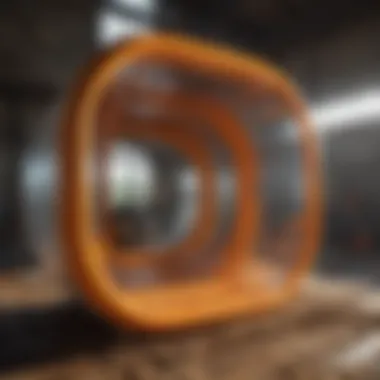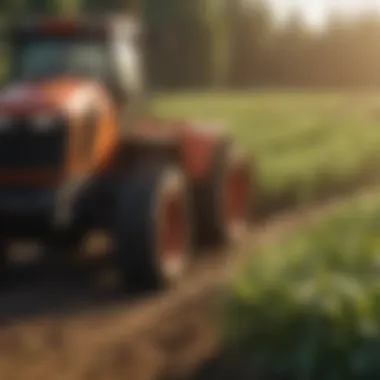Exploring Rigid Fiberglass: Uses and Innovations


Intro
Rigid fiberglass, a composite material widely recognized for its strength and versatility, has become increasingly important across various industries. This engineered composite combines glass fibers with a resin matrix, forming a material that excels in durability and thermal insulation. As industries tackle challenges like resource scarcity and environmental impact, understanding the applications and innovations associated with rigid fiberglass is crucial. This journey will explore its properties, practical applications, and the innovative advancements paving the way for a sustainable future.
Topic Overview
Definition and Importance
Rigid fiberglass is characterized by its unique composition, which gives it notable mechanical and chemical properties. The material resists moisture, chemicals, and temperature fluctuations, making it ideal for environments where these factors are prevalent. Industries such as construction, automotive, and agriculture benefit from these properties, utilizing rigid fiberglass for various applications that enhance performance and sustainability.
Brief History and Evolution
The history of rigid fiberglass dates back to the mid-20th century. Initially used in specialized applications, its usage has expanded significantly over the decades. Its lightweight nature combined with impressive tensile strength has allowed for greater flexibility in design and construction. The evolution of manufacturing processes, such as resin transfer molding and pultrusion, has transformed how rigid fiberglass is produced, emphasizing efficiency and environmental consideration.
Key Techniques and Innovations
Advanced Manufacturing Processes
The manufacturing of rigid fiberglass has seen significant innovation. Today's methods allow for intricate shapes to be created with high precision. Techniques like vacuum infusion increase efficiency and reduce waste—this is vital in the push towards sustainability in materials.
Sustainable Practices
Current trends highlight the importance of sustainability in material choices. Rigid fiberglass can be produced using recycled materials, minimizing the ecological footprint. Its longevity in use and recyclability at the end of its life cycle further support its position as a sustainable option.
Practical Applications
Diverse Applications
Rigid fiberglass is applied across various fields:
- Construction: Used for insulation and aesthetic panels.
- Automotive: Found in body panels and internal components.
- Agriculture: Effective in storage tanks and equipment casings.
Each sector takes advantage of the material's durability and resistance to adverse conditions.
Case Studies
Examining specific use cases reveals rigid fiberglass’s widespread acceptance:
- Commercial Greenhouses: Utilizing rigid fiberglass for panels ensures a durable, insulated environment that maximizes plant growth.
- Automobile Manufacturing: Major brands incorporate fiberglass components to enhance fuel efficiency without compromising structural integrity.
In summary, rigid fiberglass not only meets current industry demands but also opens avenues for future development, demonstrating its significance in a variety of applications. Innovations and sustainable practices in rigid fiberglass production position the material as a cornerstone for responsible industrial growth.
Prologue to Rigid Fiberglass
Rigid fiberglass represents a significant advancement in material science. In various industries, its unique properties contribute to enhanced performance and efficiency. This section aims to lay the groundwork for understanding rigid fiberglass, setting the stage for detailed explorations of its applications and attributes.
Definition and Composition
Rigid fiberglass is an engineered composite made primarily of glass fibers and thermosetting resins. The glass fibers provide exceptional tensile strength and stiffness, while the resin binds these fibers together, creating a solid structure. This combination produces a lightweight yet durable material, ideal for numerous applications.
The composition of rigid fiberglass can vary, allowing for the customization of its properties. Different types of glass fibers, such as E-glass (Electrical glass) or S-glass (Structural glass), may be utilized for specific strength or thermal resistance objectives. The resins used, including epoxy, polyester, or vinyl ester, further influence the overall performance and usability of rigid fiberglass in distinct environments.
Historical Development


The journey of rigid fiberglass began in the early 20th century, with significant advancements in the dyeing and textile industries. Initially, glass fibers were used primarily in insulation and fireproofing materials. However, by the 1930s, engineers and manufacturers recognized their potential in composite materials.
Post World War II saw a surge in the use of fiberglass in various sectors, propelled by the aerospace and automotive industries. Innovations in manufacturing processes and introduction of high-strength fibers expanded the possibilities for rigid fiberglass. Today, it is implemented widely in agriculture, construction, and many other fields, representing a versatile solution to modern material needs.
"Rigid fiberglass combines robustness and lightweight characteristics, making it an essential material in diverse applications."
In summary, understanding rigid fiberglass's definition and historical context provides crucial insights into its applications and innovations. The next sections will explore these facets further, revealing how this material continues to shape industries and drive advancements.
Manufacturing Process of Rigid Fiberglass
The manufacturing process of rigid fiberglass is fundamental to understanding how this material achieves its notable properties. This section will discuss the raw materials used, production techniques employed, and the quality control measures undertaken during manufacturing. Each of these components contributes not only to the durability and performance of rigid fiberglass, but also to its suitability across various applications, including those in the agricultural sector.
Raw Materials
The quality of rigid fiberglass begins with its raw materials. The primary component is glass fiber, which is typically derived from silica sand. This raw material is melted at very high temperatures and then drawn into thin strands of fiber. Other essential materials include resins such as epoxy or polyester. These resins are critical as they bind the glass fibers, providing structural integrity and enhancing resilience.
Additionally, various additives are utilized to give the fiberglass specific properties. For instance, flame retardants may be included to improve fire resistance, or UV stabilizers to combat degradation from sunlight. The careful selection and combination of these materials determine the final characteristics of the fiberglass, making it crucial for manufacturers to understand how each component will affect the overall product.
Production Techniques
The production of rigid fiberglass involves several techniques that ensure the final product is both robust and versatile. One common method is the hand lay-up process, where layers of glass fibers are soaked in resin and laid by hand into molds. This method is favored for its flexibility and low cost, allowing for the creation of complex shapes.
Another prominent technique is the spray-up method, where chopped glass strands are mixed with resin and sprayed into a mold. This technique is more efficient for large production runs and yields faster cycle times. Autoclave curing, often employed for high-performance applications, uses heat and pressure to fully cure the fiberglass composite, increasing its mechanical strength and thermal stability.
Each of these techniques has specific advantages and is selected based on the intended application of the fiberglass. The choice of production method significantly impacts both the quality of the material and its suitability for different uses, such as agricultural equipment or building materials.
Quality Control Measures
Quality control is an essential component in the manufacturing process of rigid fiberglass. It ensures that the finished products meet stringent industry standards and perform as expected. During production, several checks are put in place. Raw material inspections are conducted to verify the consistency and quality of incoming glass fibers and resins. This step is crucial, as any defects in materials can lead to failures in the final product.
In-process monitoring is also vital. This can include temperature checks during curing and visual inspections for defects in the fiberglass layers. Sampling and testing of finished products are performed as well, measuring properties such as tensile strength, impact resistance, and thermal conductivity. By adhering to rigorous quality control processes, manufacturers can guarantee that their rigid fiberglass offerings will withstand the demands of their intended applications.
Ensuring high-quality production of rigid fiberglass can significantly improve its longevity and safety in real-world applications, emphasizing its importance in construction, automotive, and agricultural sectors.
In summary, the manufacturing process of rigid fiberglass integrates various raw materials, advanced production techniques, and stringent quality control measures. Each of these aspects plays a crucial role in defining the performance and reliability of the final product, making rigid fiberglass a critical material across numerous industries.
Key Properties of Rigid Fiberglass
The exploration of rigid fiberglass is clearly incomplete without addressing its key properties. These characteristics define the usefulness and adaptability of the material across various industries, including construction, automotive and agriculture. Understanding these properties not only reveals the functionality of rigid fiberglass but also its significance for agriculture farmers and enthusiasts.
Mechanical Strength
Mechanical strength is a primary attribute of rigid fiberglass. This material exhibits high tensile and compressive strengths, making it ideal for applications demanding durability. The composite structure of fiberglass fibers combined with resin creates a firm, stable foundation that resists deformation under stress. For farmers, this means that tools or components made from rigid fiberglass can withstand significant wear and pressure without failing.
Furthermore, the mechanical strength is crucial in the construction of agricultural machinery and equipment. Structures need materials that do not buckle under load, which rigid fiberglass accommodates effectively. Its resistance to impact means it can handle the rough conditions of farm life and continue performing reliably.
Thermal Insulation
Thermal insulation is another vital property, which rigid fiberglass excels at. This material has excellent insulating capabilities, keeping environments either warm or cool as needed. In agricultural settings, temperature control in storage facilities can determine the success of stored produce. Rigid fiberglass panels can help maintain stable temperatures, ultimately ensuring better preservation of crops.
This property is also relevant for livestock management. Insulating barns with rigid fiberglass can create a more favorable climate for animals, shielding them from extreme heat or cold. The energy efficiency gained from utilizing rigid fiberglass thus contributes to both sustainable farming practices and cost savings.
Chemical Resistance
Agriculture often involves exposure to various chemicals—fertilizers, pesticides, and herbicides. Rigid fiberglass exhibits strong chemical resistance, meaning it can withstand corrosive substances without deteriorating. Farmers can use equipment and storage solutions made from fiberglass without concern of quick degradation, which can lead to costly replacements.


This is particularly important for fiberglass tanks or containers used to store chemicals. The long lifespan of rigid fiberglass ensures that farmers do not face frequent interruptions or hazards from leaks or material failures. Maintaining safety in an agricultural environment is not just an obligation but also critical for ensuring productivity.
Lightweight Characteristics
One often overlooked aspect of rigid fiberglass is its lightweight nature. Compared to metals or other composites, rigid fiberglass is significantly lighter while still retaining strength. This characteristic simplifies the transport and handling of tools, machinery, and components in agricultural settings.
For instance, a lightweight fiberglass structure is easier to install, relocate, or replace. This convenience can lead to increased efficiency on farms, enhancing the overall productivity. Additionally, the reduced weight of equipment can minimize the energy expenditure associated with their operation.
Understanding these key properties allows farmers and agricultural enthusiasts to make informed decisions about material selections in their operations, paving the way towards greater efficiencies and sustainability.
Applications of Rigid Fiberglass
The applications of rigid fiberglass showcase its versatility and utility across various industries. This material is increasingly favored for its excellent mechanical properties and resistance to environmental factors. By understanding its practical uses, one can appreciate the significance of rigid fiberglass in modern production and construction.
Construction Industry
The construction industry benefits extensively from the use of rigid fiberglass. It is commonly employed in creating building panels, roofing materials, and insulation. Rigid fiberglass is known for its high strength-to-weight ratio, making it an ideal choice where durability is essential without adding excessive weight to structures.
Additionally, its insulating properties help improve energy efficiency in buildings. It resists moisture and pests, contributing to the longevity of construction projects. These characteristics make rigid fiberglass a preferred material in both residential and commercial applications. With increasing energy regulations, the use of fiberglass insulation is likely to grow.
Automotive Sector
Rigid fiberglass plays a crucial role in the automotive sector. It is used in vehicle body components, such as panels and bumpers, due to its lightweight and robust nature. This contributes to fuel efficiency, as lighter vehicles consume less energy. Furthermore, rigid fiberglass is resistant to corrosion and impacts, enhancing vehicle safety and longevity.
The use of this material also opens avenues for innovative designs. Manufacturers can create complex shapes that are difficult to achieve with traditional materials. This design flexibility may lead to advancements in vehicle aesthetics and functionality, ensuring that the automotive sector continues to evolve.
Agricultural Uses
In agriculture, rigid fiberglass is increasingly recognized for its usefulness. It is utilized for creating durable storage tanks and containers for water and fertilizers. The non-corrosive nature of rigid fiberglass means that it doesn't react with chemicals, ensuring the integrity of stored substances. These tanks can withstand harsh climates and resist UV damage, making them suitable for outdoor applications.
Additionally, rigid fiberglass can be found in greenhouse construction, providing strong and insulated panels that allow optimal growth conditions for plants. The durability and moisture resistance help reduce maintenance needs, thereby saving time and resources for farmers.
Electronics and Consumer Goods
The electronics industry also leverages rigid fiberglass in the production of circuit boards and housing for devices. Its insulating properties prevent electrical interference and improve safety, while its ability to be molded into different shapes allows for a variety of designs tailored to specific consumer needs.
For consumer goods, products like housing for appliances and tools often utilize rigid fiberglass for its durability and aesthetic appeal. This material provides robustness while maintaining a lightweight profile, making it ideal for daily use. As the demand for reliable and sustainable materials grows, the role of rigid fiberglass in electronics will likely continue to expand.
"The versatility of rigid fiberglass positions it as a central material across diverse industries, driving innovation and sustainability."
In summary, rigid fiberglass's applications span numerous sectors, highlighting its significance in modern material science. Its properties enable advancements in construction, automotive, agriculture, and consumer goods, making it a pivotal element in these industries.
Environmental Impact of Rigid Fiberglass
Understanding the environmental impact of rigid fiberglass is essential in today's context of sustainability. This material, while versatile and widely used, poses specific challenges and benefits that need to be addressed. With increased scrutiny on how materials affect our planet, the importance of examining the life cycle of rigid fiberglass cannot be overstated. Exploring its sustainability considerations and the challenges associated with its recycling and disposal will provide insight into its true environmental footprint.
Sustainability Considerations
Sustainability in the context of rigid fiberglass revolves around its composition, production methods, and end-of-life management. The primary ingredients of rigid fiberglass include glass fibers and resin, which are obtained through intensive processes. Though rigid fiberglass has many advantages such as durability and insulation properties, these benefits come with environmental costs during manufacturing. The extraction of raw materials and energy-intensive production can contribute to carbon emissions.
However, rigid fiberglass does offer significant sustainability benefits in application. Its durability allows for long-term use, reducing the need for frequent replacements and conserving resources. Additionally, rigid fiberglass has excellent thermal insulation qualities, which help lower energy consumption in buildings, thus contributing to more sustainable energy usage overall.
Recycling and Disposal Challenges


One significant environmental challenge regarding rigid fiberglass is the recycling process. Unlike traditional materials like metals or plastics, rigid fiberglass is not easily recyclable. The mixture of glass and resin creates complications in separation. Currently, there are limited facilities equipped to handle fiberglass recycling, which results in a substantial amount being sent to landfills.
Efforts are ongoing to develop better recycling processes. Some initiatives focus on grinding down fiberglass waste to use as filler materials in other products. Although these solutions are promising, they are not yet widely adopted. Disposal remains a critical issue because once in a landfill, fiberglass can take decades to decompose.
"The future of rigid fiberglass hinges on innovation in recycling technology and sustainable practices that minimize waste."
Innovations in Rigid Fiberglass Technology
The landscape of materials science constantly evolves due to new innovations. Rigid fiberglass technology is no exception. This section explores modern advancements that enhance its properties and functionalities, making it more applicable across various sectors. Understanding these innovations is crucial for industries looking to optimize production efficiency and sustainability.
Advanced Manufacturing Techniques
Innovations in manufacturing processes of rigid fiberglass are imperative for improving efficiency, reducing costs, and enhancing durability. Techniques such as automated fiber placement and resin infusion are gaining traction.
- Automated Fiber Placement (AFP): This method allows the precise placement of fiberglass fibers. The automation minimizes human error, ensuring uniformity in products. As a result, it contributes significantly to the mechanical strength of the materials produced.
- Resin Infusion: A crucial step in the manufacturing of rigid fiberglass involves the infusion of resin into the fiberglass mat. This technique maximizes the bond between fibers and resin, improving the overall performance of the end product. By using vacuum techniques, manufacturers can achieve a more consistent bond, leading to fewer defects.
- 3D Printing of Composites: Emerging technologies such as 3D printing are transforming how rigid fiberglass components are made. This method allows for rapid prototyping and customization of parts. The ability to create complex geometries is paving the way for innovations in industries that require specific design modifications, especially in automotive and aerospace sectors.
New Applications in Emerging Markets
As rigid fiberglass technology advances, its applications continue to expand into new markets. This section highlights some of the promising areas where rigid fiberglass is becoming increasingly relevant.
- Renewable Energy: The use of rigid fiberglass in wind turbine blades is a significant advancement. Its lightweight and strong characteristics contribute to improved energy efficiency. Such applications are essential in the growing field of renewable energy, where sustainability is key.
- Construction and Infrastructure: Innovations have led to the integration of rigid fiberglass in various architectural designs. As a composite material, it allows architects to create structures that are not only visually appealing but also highly durable. The resistance to weather conditions makes it suitable for outdoor applications.
- Agricultural Tools: The agricultural sector is exploring the use of rigid fiberglass in manufacturing tools and machinery. The material's resistance to chemicals and moisture makes it ideal for agricultural environments, which often expose equipment to harsh conditions.
"The evolution of rigid fiberglass technology opens up new dimensions for sustainable practices across various industries."
- Healthcare Equipment: The healthcare industry is looking at rigid fiberglass for equipment that requires hygiene and robustness. Containers for storing medical supplies or instruments that need insulation from shock and temperature variations are areas seeing interest.
These innovations underscore the versatile nature of rigid fiberglass, empowering industries to embrace its benefits. As markets evolve, rigidity and lightweight characteristics combined with novel applications could define the future landscape of materials used in key sectors.
Future of Rigid Fiberglass
The evolution of rigid fiberglass is marked by its adaptability and enduring relevance in various industries. As technology advances, so does the potential for innovative applications of this composite material. This section will dissect the market trends influencing the future of rigid fiberglass, as well as potential areas for development that could redefine its usage.
Market Trends
The current market trends surrounding rigid fiberglass reflect a growing demand for sustainable and versatile materials. Several factors are driving this trend:
- Sustainability: As industries place emphasis on eco-friendly practices, rigid fiberglass emerges as an attractive option. Its durability extends product lifecycles, thereby reducing waste and the need for frequent replacements.
- Technological Advancements: Innovations in manufacturing processes have made rigid fiberglass more accessible and cost-effective. Automated techniques and improved resins enhance production efficiency while maintaining quality.
- Regulatory Influences: Increased regulations on materials used in construction and automotive sectors compel manufacturers to seek alternatives that meet safety and environmental standards. Rigid fiberglass, with its compliance to these requirements, stands to benefit significantly.
- Market Diversification: New applications are surfacing in various fields, from energy to consumer products. This diversification reduces reliance on traditional sectors, ensuring sustained growth.
Overall, the trends signal a positive shift in the acceptance and application of rigid fiberglass, especially in an era marked by demands for sustainable materials.
Potential Areas for Development
As demand for rigid fiberglass continues to grow, several areas present significant opportunities for development:
- Advanced Composite Materials: There is potential for integrating rigid fiberglass with other composites to enhance its performance. This fusion could yield materials that are lighter yet more robust, suitable for demanding applications.
- Smart Materials: The fusion of technology and materials science could lead to the creation of smart rigid fiberglass that responds to environmental conditions. This could revolutionize applications in construction and electronics.
- Circular Economy models: Developing effective recycling methods for rigid fiberglass will be crucial. Innovations in this space can help eliminate waste while maintaining the material's lifecycle.
- Niche Marketing: Targeted marketing toward specific sectors, such as renewable energy or specialized automotive applications, can uncover new customer bases.
"The future development of rigid fiberglass may transform it into a key player in sustainable solutions across multiple industries."
Finale
The conclusion of this article serves as a vital recap of the intricate world of rigid fiberglass. This material is indispensable in various industries due to its diverse range of properties and applications. Understanding rigid fiberglass extends beyond its basic characteristics; it emphasizes the significance of innovation and sustainability in today’s production processes.
Summary of Key Points
Rigid fiberglass, as detailed in the sections above, is a material that stands out for multiple reasons. These points are crucial for industry stakeholders:
- Definition and Composition: Rigid fiberglass is primarily composed of glass fibers, resin, and additives, contributing to its robustness and thermal insulation.
- Manufacturing Process: The production of rigid fiberglass involves careful selection of raw materials and advanced manufacturing techniques, ensuring a high-quality end product.
- Properties: Key properties include mechanical strength, thermal insulation, chemical resistance, and lightweight characteristics. These properties enhance its suitability for construction, automotive, and agricultural applications.
- Innovations: Ongoing advancements in manufacturing and novel applications in emerging markets signify a promising future for rigid fiberglass.
- Environmental Considerations: Sustainability and recycling are essential topics that affect the future of this material, making it important for manufacturers to adapt practices that consider environmental impact.
Final Thoughts on Rigid Fiberglass
As we reflect on the discussions in this article, it's clear that rigid fiberglass is not just a static material but rather a dynamic composite that is evolving. Its growing presence in sectors like agriculture highlights its adaptability. Understanding the properties and applications of rigid fiberglass empowers professionals to make informed choices in material selection. The innovations in this field promise advancements that can lead to more sustainable practices while taking advantage of the material's strengths. Therefore, it becomes essential for farmers and industry professionals to stay informed about rigid fiberglass developments, harnessing them for improved efficiency and sustainability.



